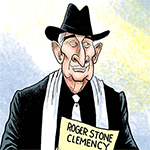Sports
/ArcaMax

Sam McDowell: Josh Simmons 'surprised' the Chiefs in first practice. Why next step is critical.
KANSAS CITY, Mo. — The Chiefs brought their draft picks, free-agent rookies and tryout hopefuls to Kansas City last weekend, nearly 90 of them in all.
This column is about the future of just one — because it’s the player on which the success of the Chiefs’ 2025 draft class should pivot.
Josh Simmons.
If the Chiefs have found a ...Read more

Paul Zeise: Steelers are in the same bad position at wide receiver they were in last year
PITTSBURGH — I listened with intent and learned from Omar Khan this past week when he met with the media and talked about the wide receiver position.
Khan’s contention is the Steelers are in a much better spot than they were last year, even though they only have one legitimate top receiving option on the roster. I am willing to concede ...Read more

Jim Harbaugh taking a new approach to evaluating Chargers' rookie talent
LOS ANGELES — Before the Chargers put diamonds in any Super Bowl rings, Jim Harbaugh is looking for diamonds on the practice field.
"Rare gems, they don't just hop out of the ground and into your pocket," the Chargers coach said as the team began rookie minicamp Friday. "You gotta dig."
The Chargers are searching for their hidden gems ...Read more

Saints QB Derek Carr announces retirement in stunning statement
LAS VEGAS — Derek Carr, who rewrote the Raiders’ record book during his nine seasons with the club, is retiring from football after suffering a serious shoulder injury last season with the Saints.
Carr, 34, spent the past two seasons with New Orleans after being released by the Raiders following the 2022 season. The lingering effects of the...Read more

Mac Engel: George Pickens' success with the Cowboys will hinge on Dak Prescott
FORT WORTH, Texas — Amari Cooper’s unwillingness to take a shot, Michael Gallup’s ACL, and the “presence” of Ryan Flournoy, Jalen Brooks and Jalen Tolbert forced the Cowboys to bring in a person who could emasculate Brian Schottenheimer long before Jerry does.
George Pickens was not going to eat up Pittsburgh head coach Mike Tomlin ...Read more

Omar Kelly: Dolphins have big rookie class, with bigger expectations
MIAMI — Zeek Biggers’ calves are the size of tree trunks, and they’re needed to hold up his 6-foot-6, 320-pound frame, which based on my Lasik-assisted eyes might be a conservative weight listing.
Probably a weight recommendation because this defensive lineman from Georgia Tech is a big man, arguably the biggest of all the newcomers on ...Read more

Jason Mackey: New Steelers RB Kaleb Johnson defined by loyalty, tenacity and humility
PITTSBURGH — A few times per month, sometimes without warning, Nate Mahon will look down at his phone and see Kaleb Johnson on the other end, the new Steelers running back eager to FaceTime with Mahon's three kids.
Mahon coached Johnson at Hamilton High School, located outside of Cincinnati. He visited the University of Iowa about a half-...Read more

GM Omar Khan: Trading George Pickens provides 'a fresh start' for Steelers
PITTSBURGH — Steelers general manager Omar Khan doesn't make it a habit of discussing every move and every transaction throughout the offseason. His usual checkpoints are the NFL combine, league owners meetings and the draft, followed by a moratorium until the start of training camp.
But George Pickens is different. And Friday, after the team...Read more

Omar Kelly: Are Dolphins embarking on a leadership crisis?
MIAMI — For one minute, or however long it takes to read this, let’s forget about the perception that the 2025 Miami Dolphins are a finesse team, or needed to beef up the trenches, becoming tougher, more physical.
There’s plenty of truth to that accusation, and evidence of it can be found in how the team’s decision-makers altered their ...Read more

Ray Fittipaldo: Steelers have long history of drafting risky receivers, but recent picks have been more problematic than productive
PITTSBURGH — Drafting receivers with troubled backgrounds is nothing new to the Steelers. They've done it for decades now and for years managed to maximize their talents before jettisoning them when there was a point of diminishing return. Santonio Holmes is the perfect example of that.
The Steelers traded up in the first round of the 2006 ...Read more

Ex-Detroit Lion Stanley Wilson Jr. died in custody. His mom's weekend vigil remembers him and others like him.
LOS ANGELES — In a brutal bit of irony, in-custody deaths in Los Angeles were brought to the forefront by a 2023 case in which neither the County Sheriff's Department or county hospitals would acknowledge that an inmate was in their custody when he died.
Stanley Wilson Jr., a Stanford graduate and former NFL defensive back with the Detroit ...Read more

Shedeur Sanders fan sues NFL for $100 million over draft drop: 'severe emotional distress'
LOS ANGELES — A football fan is suing the NFL for $100 million over the "severe emotional distress and trauma" that he suffered when former Colorado quarterback Shedeur Sanders unexpectedly dropped to the fifth round of last month's draft.
In a lawsuit filed May 1 in the U.S. District Court for the Northern District of Georgia, Buffaloes fan ...Read more

Panthers release veteran OLB Jadeveon Clowney, save cap space
CHARLOTTE, N.C. — Jadeveon Clowney will be looking for work elsewhere in 2025.
The Carolina Panthers released Clowney on Thursday, a league source confirmed. ESPN was the first to report the move.
The move will open up $7.78 million in salary cap space, according to Over The Cap. However, because the Panthers couldn’t trade Clowney, they�...Read more

Rams expanding markets, beginning with minicamp in Hawaii
LOS ANGELES — Rams coach Sean McVay typically rewards players for their dedicated voluntary offseason work by not holding a mandatory minicamp.
This year, players are apt to welcome one.
The Rams and the Hawaii Tourism Authority announced on Wednesday that the Rams will hold a minicamp and other events on Maui from June 16-18.
Rams ...Read more

Joe Starkey: Mike Tomlin ignored the warning signs on George Pickens and ultimately paid the price
PITTSBURGH — The most amazing part of the George Pickens story is that so many people thought Pickens was going to grow up on a moment's notice and make it work with the Steelers for one final season.
What have they been watching for the past three years?
They thought Pickens, who is headed to the Dallas Cowboys for essentially a third-round...Read more

Jason Mackey: After George Pickens trade, the Steelers better have a logical succession plan
PITTSBURGH — It very well might be addition by subtraction.
The Steelers' value proposition also includes essentially taking a third-round pick now versus potentially getting production while also risking a potential George Pickens crash out.
Where the equation doesn't balance for me involves the idea of timing.
In other words, why did the ...Read more

Steelers trading WR George Pickens to Cowboys
PITTSBURGH — The Steelers are planning to trade truculent receiver George Pickens to the Dallas Cowboys for a third-round pick in the 2026 draft, a move they believe has no bearing or impact on quarterback Aaron Rodgers signing with the team, sources have told the Pittsburgh Post-Gazette.
The trade, which developed in just the past couple ...Read more
Paul Zeise: Steelers' Ben Roethlisberger is an all-time great, but his place in history is right where it should be
PITTSBURGH — Terrell Suggs is one of the fiercest rivals among opposing players the Steelers have faced over the last two or three decades.
In many ways, Suggs, Ray Lewis and Ed Reed probably are the three players who most define the beauty of the Steelers-Ravens rivalry. Oh, there are many other names and guys like Joe Flacco whom Steelers ...Read more

Will former Ravens kicker Justin Tucker ever play football again?
BALTIMORE — Justin Tucker spent the past 13 years with the Ravens, making him what had been the longest-tenured player on the team. That tenure in Baltimore came to an unceremonious and extraordinary end with his release Monday.
Now the question is: Is his NFL career over, too?
While general manager Eric DeCosta’s statement announcing the ...Read more

Sizing them up: Breaking down the strengths and weaknesses of top NFL rookie QBs
LOS ANGELES — Although it felt at times there was only one quarterback in last weekend's NFL draft — the slip-sliding Shedeur Sanders who tumbled to the fifth round — there were actually 14 selected over the three days. That's tied for the most taken in a draft since 2016.
Considering the impact of last year's class, which included Caleb ...Read more
Popular Stories
- Saints QB Derek Carr announces retirement in stunning statement
- Jim Harbaugh taking a new approach to evaluating Chargers' rookie talent
- Paul Zeise: Steelers are in the same bad position at wide receiver they were in last year
- Sam McDowell: Josh Simmons 'surprised' the Chiefs in first practice. Why next step is critical.
- Jason Mackey: New Steelers RB Kaleb Johnson defined by loyalty, tenacity and humility





